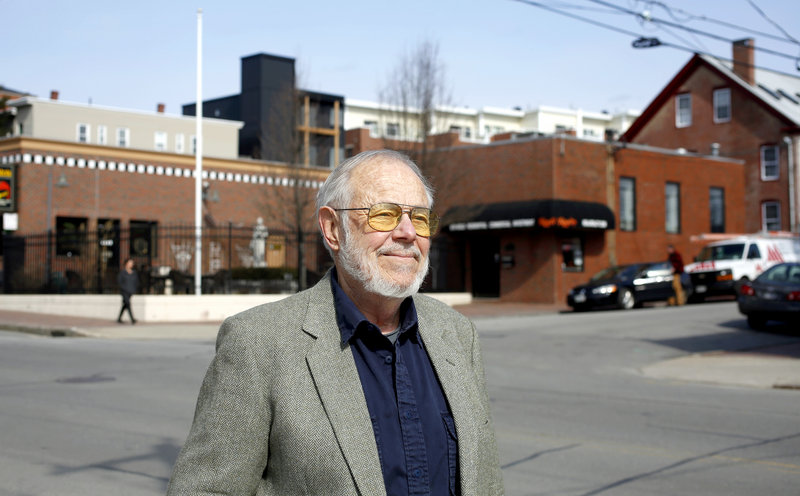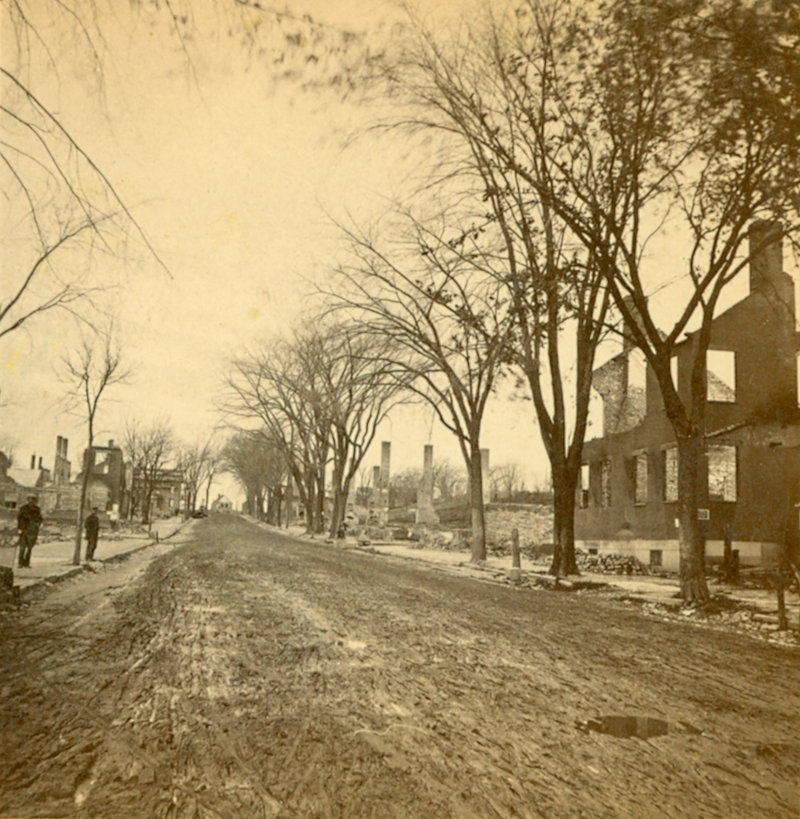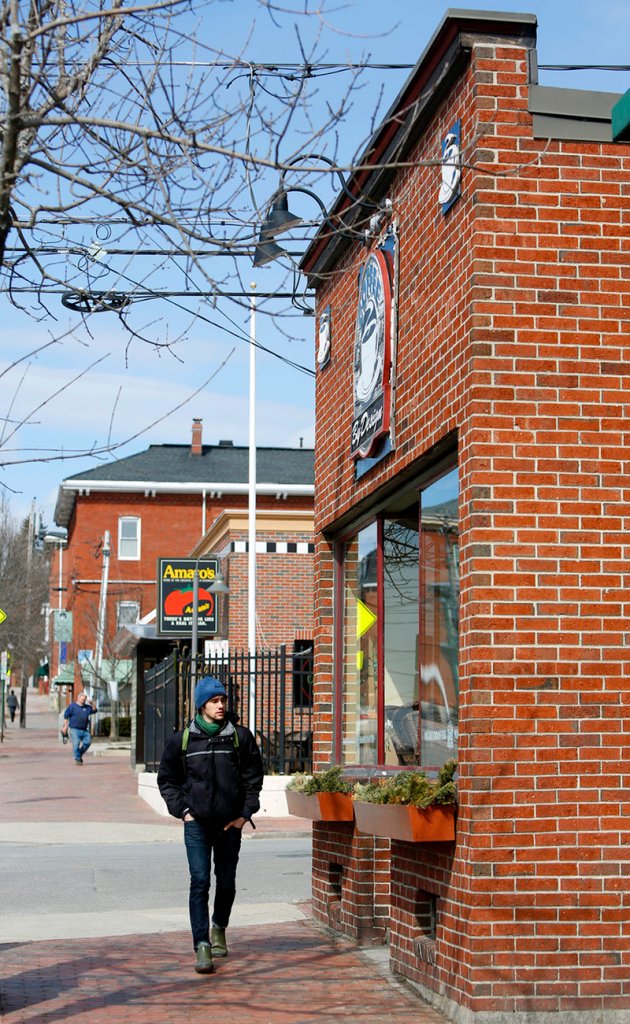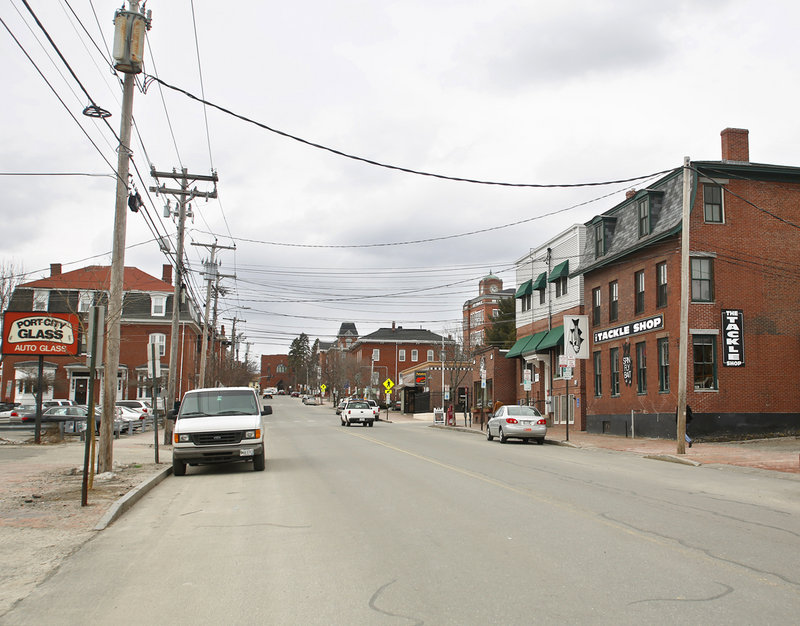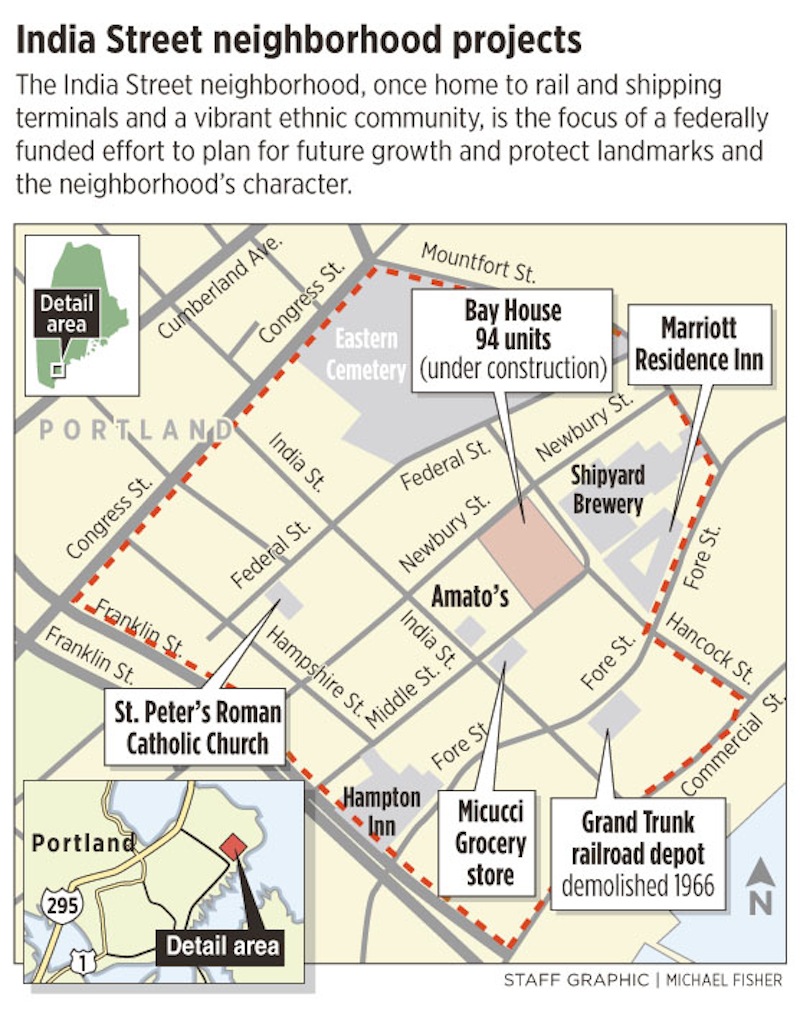PORTLAND – India Street was once the center of the city. The neighborhood around it was home to immigrants, businesses and robust international trade.
Jack Amato remembers weighing dough in his family’s bakery on India Street in the 1940s, when the vibrant, bustling community was known as Little Italy.
“In the summer, all the Italian people had gardens, especially on Newbury Street. A lot of the Italian people grew all the vegetables down there,” said Amato, 73, whose grandfather opened the first Amato’s bakery and sandwich shop on India Street in 1902.
Over the years, a series of events has reduced the 15-block neighborhood to a shadow of its former self, cut off from downtown by a major roadway and overshadowed by a resurgent Munjoy Hill.
Planners and residents are looking to change that, beginning with a neighborhood meeting Saturday.
The India Street neighborhood was selected recently by Sustain Southern Maine as one of nine Centers of Opportunity – an initiative funded with a $1.6 million grant from the U.S. Department of Housing and Urban Development.
Sustain Southern Maine is a regional coalition that works to help communities guide development to strengthen local economies, environments and neighborhoods.
Saturday’s meeting is a first step toward a draft India Street neighborhood plan, to be completed by December. A final report is due out in February.
The end product will include a map with recommended residential, commercial and mixed-use zones and building heights, said Sustain Southern Maine spokeswoman Carol Morris.
“It’s completely up to the (city) to use it, adopt it or put in on a shelf someplace,” Morris said.
Saturday’s meeting, scheduled from 12:30 to 5:30 p.m. at the Maine Jewish Museum, at 267 Congress St., will give residents, businesses and visitors a chance to provide input about the future of the neighborhood and learn about its history and architecture.
“It’s probably the best place for someone who is interested in the future of India Street to get their words in early,” Morris said.
NEIGHBORHOOD IN TRANSITION
City officials have described India Street as a neighborhood in transition.
Construction is under way on the Bay House condominiums at Middle, Hancock and Newbury streets — the former site of the Village Cafe Restaurant.
A condo project on Hampshire Street and a mixed-use development on India Street have been approved by the Planning Board, but their futures are uncertain.
In many ways, India Street has always been in transition, overcoming tragedies including three fires that wiped out the neighborhood.
In 1690, French and Indian forces overtook Fort Loyal, a wooden structure that stood near the intersection of India and Fore streets.
They drove out the colonists and torched the neighborhood, which consisted of a few buildings and residents, said Earle Shettleworth, the state historian.
In 1775, a British fleet fighting the colonial rebellion bombarded the city, which was part of Falmouth at the time, and destroyed most of the buildings around India Street.
Portland was incorporated in 1786, and the next 25 years brought dramatic growth to the India Street area, Shettleworth said.
In the mid-1800s, Portland Co. was making railroad cars for the Atlantic and St. Lawrence Railroad, which connected Portland to Montreal. The neighborhood’s waterfront was dominated by a vast rail yard, a passenger depot and towering grain elevators that moved grain from train cars onto ships.
One lone brick section of the old Grand Trunk Station still stands, near the corner of India and Fore streets.
Steamships arrived at the foot of India Street carrying waves of European immigrants, as well as European textiles and other goods that were off-loaded and taken to Montreal via the Grand Trunk rail, Shettleworth said.
Montreal sent back grain supplies, which were stored on the waterfront and shipped to points in New England and overseas.
India Street was also the heart of a thriving neighborhood and a popular place for wealthy and middle-class families.
The era of growth came to an abrupt end when the neighborhood was virtually destroyed by the Great Fire of 1866.
SHOULD BE ‘DOWNTOWN ADJACENT’
After the fire, India Street never regained its prestige.
The core of downtown Portland shifted into what is today’s Old Port. Wealthy residents began taking up residence on the West and East ends of the city, leaving India Street largely to middle-income Italian and Jewish immigrants, Shettleworth said.
In 1967, about 100 residences that were home to many Italian families were demolished to make way for Franklin Arterial, which effectively severed the neighborhood from the downtown.
“This little pocket here continually bled residents,” said Hugh Nazor, secretary of the India Street Neighborhood Association. “The whole place went downhill.”
According to the 2010 U.S. Census, the neighborhood has 362 homes, 310 of which are rental units.
Of the 473 people who lived there in 2010, the vast majority were white (421), followed by Asians (20) and blacks/African Americans (14).
Its residents tend to be younger than those in other parts of the city — from their mid-20s to mid-30s — with areas that have higher concentrations of baby boomers.
Until recently, Nazor said, India Street has not been considered a distinct neighborhood by city planners. Its zoning is the result of planning efforts for four other areas — East Bayside, the downtown, Munjoy Hill and the eastern waterfront.
India Street should be considered a “downtown adjacent” neighborhood rather than being incorporated into the downtown district, he said. As such, remaining historic buildings should be preserved and future buildings should be limited to three stories, he said.
Nazor points to downtown zoning that was extended to eastern waterfront lots and could allow buildings as tall as 65 feet in the neighborhood.
Such a height limit, he said, could open the door to “the largest mistake made on the peninsula in decades — that’s the parking garage.”
Sustain Southern Maine’s work will eventually be included in a neighborhood-wide plan, said Jeff Levine, the city’s planning director.
The city had hoped to begin work on that plan soon, but it still lacks funding for the roughly $100,000 study.
Levine said the city will move forward with a survey to determine which buildings are historic and should be preserved. But the rest of the neighborhood plan is being put on hold.
“It’s a priority for us to find the funding,” Levine said.
The Sustain Southern Maine project is a step in the right direction for the historic neighborhood, he said. “We see this as part of establishing a good baseline for that plan.”
Randy Billings can be contacted at 791-6346 or at:
rbillings@pressherald.com
Twitter: @randybillings
Send questions/comments to the editors.


